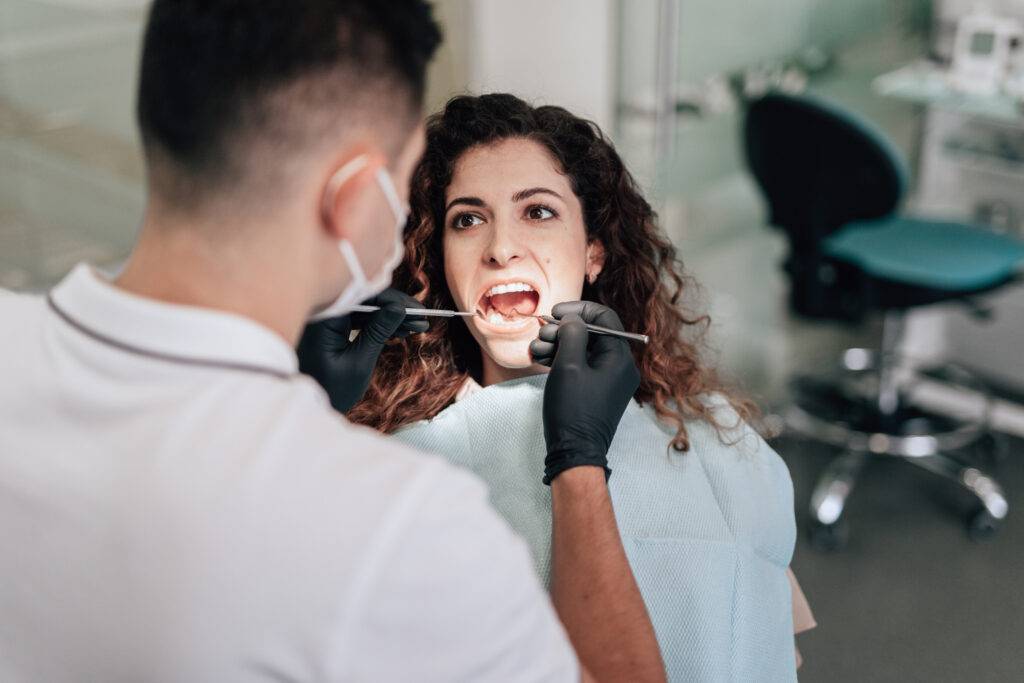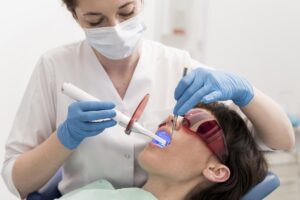When bacteria overrun the tooth’s core, causing infection, opting for a root canal is key. This procedure is vital for saving the tooth and preventing further spread of infection. During a root canal, the infected pulp is carefully removed and cleaned.
If you’re grappling with persistent tooth pain or pulp discomfort, it’s crucial to seek help from a trusted dental clinic. After a thorough assessment, the dental expert can advise on the best treatment options.
Causes Behind Gum Disease
Numerous factors contribute to gum disease, with the primary culprit being inadequate oral hygiene. Neglecting regular brushing and flossing allows plaque to accumulate on teeth and gums, fostering bacterial growth and ultimately leading to gum disease. Other factors contributing to gum disease encompass tobacco use, specific medications, diabetes, pregnancy, and genetic predisposition.
If gum disease is present, seeking dental intervention is imperative for proper treatment. Treatment options may entail scaling and root planing (a deep cleaning), antibiotics, or surgical procedures.
Signs of Gum Disease
Gum disease, medically known as periodontal disease, constitutes a severe infection affecting the gums and supporting bone structure of the teeth. This condition arises from plaque buildup, a sticky amalgamation of food particles and bacteria adhering to teeth surfaces. The irritation caused by plaque results in inflamed, swollen, and easily bleeding gums. Without intervention, plaque hardens into calculus (tartar), exacerbating gum irritation and progressing to gum disease.
Common symptoms of gum disease include
- Red, swollen, or bleeding gums
- Gum recession, causing teeth to appear longer
- Presence of pus between teeth and gums
- Loose or shifting teeth
- Persistent halitosis (bad breath)
- Changes in the fit of partial dentures
If any of these symptoms are noticed, prompt dental consultation is crucial. Early detection and treatment of gum disease can mitigate the risk of more severe complications in the future.

Treatment Options for Gum Disease
Addressing gum disease typically involves the removal of plaque and tartar from teeth surfaces. Professional dental cleanings are vital for this purpose. In advanced cases, additional treatments such as scaling and root planing may be necessary. This procedure entails numbing the gums and removing plaque and tartar from below the gumline. In certain instances, surgical intervention might be required to address gum disease.
Maintaining consistent oral hygiene practices at home is essential for individuals with gum disease. This includes brushing teeth twice daily with fluoride toothpaste, daily flossing, and the use of antibacterial mouthwash. Regular dental visits for professional cleanings and examinations are also crucial.
Preventive Measures for Gum Health
Several preventive measures can help ward off gum disease or prevent its progression. Firstly, adhere to a routine of brushing teeth twice daily and flossing at least once daily to remove plaque from teeth and gums. Secondly, schedule regular dental appointments for cleanings and checkups to remove tartar buildup and detect any issues early. Thirdly, abstain from tobacco use, as smoking is a significant risk factor for gum disease. Lastly, maintain a balanced diet and limit consumption of sugary foods and beverages to promote dental and gum health.
Dispelling Common Myths About Gum Disease
Various myths and misconceptions surround gum disease, leading to misunderstandings about its causes and effects. Contrary to popular belief, gum disease is not solely a consequence of poor oral hygiene; genetic factors, smoking, certain medications, and hormonal changes also play significant roles. Additionally, gum disease is not restricted to adults but can affect individuals of all ages, including children and adolescents. Lastly, while brushing and flossing are important components of oral hygiene, they alone cannot prevent gum disease; regular professional cleanings and exams are essential for comprehensive oral health.
Ending Up
Gum disease threatens oral health, potentially causing lasting damage. Early symptom recognition is crucial to prevent deterioration. With proper care, gum disease can be reversed. Regular brushing, flossing, and dental visits are essential for prevention. Seek guidance from your dentist if you notice any symptoms.
- Understanding the Causes of Gum Disease
Plaque, a sticky bacterial film on teeth, is the main cause
of gum disease. When it hardens into tartar, it leads to gum inflammation
called gingivitis. Untreated, gingivitis advances to periodontitis, harming teeth and supportive tissues.
- Identifying Symptoms of Gum Disease
Detecting gum disease early can be tough. Signs like bleeding gums after brushing, receding gums, bad breath, or gum tenderness may indicate it. Advanced stages may show loose teeth or changes in denture fit.
- Exploring Treatment Options for Gum Disease
Treatment for gum disease depends on its severity. Early gingivitis can often be reversed with good oral hygiene and regular cleanings. Advanced periodontitis may require deep cleanings, antibiotics, or surgery to address infection-induced damage.





